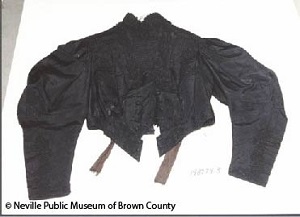From the Education Department: National Jewel Day
Today is National Jewel Day, and among our collection at the Neville Public Museum, we have this lovely amethyst gemstone courtesy of Robert Berndt.
While always having a purple appearance, the color of amethyst stones can greatly differ. It can vary from a pale lavender to a vivid reddish violet. With such contrasting colors and being such a plentiful gemstone, amethyst’s value depends on its hue. The more vibrant the stone appears indicates a higher price that it can sell for.Even though its worth is based on its appearance now, that was not always the case. Ancient Greeks and Romans associated amethyst with warding off drunkenness since both societies believed that the stone was discovered by their god of wine. Ancient Egyptians centered amethyst even more than the other two cultures, though; they created amethyst amulets to bring them closer to the divine and to protect them against harm. They also carved jewelry out of amethyst. Even though the designs were originally simplistic, later designs became much more extravagant.
Many early Christians also associated amethyst with their god. They believed that the lighter purples represented a virtuous soul, and the darker violets and reds symbolized humility and purity one experiences from suffering. Some believed that the deeper shades stood for Christ’s hardships in death. Because of that, Christians previously use amethyst for healing wounds. Amethyst symbolism surrounding Christianity is culturally significant even in the modern day. Being the birthstone of February, it represents love because, as legend states, St. Valentine wore a ring with Cupid’s portrait carved out of amethyst.
These cultures were not the only ones that believed in the healing powers of amethyst. The stone was thought to bring a calming presence and connect one more to their deities, their mind, and their existence, and they were used throughout societies and religions worldwide.Not only was amethyst important spiritually, it also was a symbol of wealth. Purple has been historically associated with royalty, so therefore, monarchies were prone to adapt a violet gemstone into their jewelry. It was also known as rare until the 19th century because it was throughout Europe. Brazil had many amethyst deposits, though, and once that was discovered, its value diminished significantly.
Amethyst symbolism is culturally significant even in the modern day. Being the birthstone of February, it represents love because, as legend states, St. Valentine wore a ring with Cupid’s portrait carved out of amethyst.
Psychics and reiki practitioners swear by the benefits of incorporating amethyst into one’s daily life (such as carrying the stone around with you, meditating while holding it, and speaking wishes to it). They claim this will improve one’s physical health (enhancing the immune system, improving skin and digestive health, reducing headaches, and regulating hormones), mental health (promoting peace and clarity), and connection to the metaphysical. Despite these claims, the use of amethyst for health has no scientific backing.
Geologists love amethyst because it can be a clue in understanding the structure of the surrounding land. Amethyst is often found alongside volcanic rocks; thus, it can mean there has been volcanic activity in the area. It often forms in hydrothermal veins, which are cracks in the Earth’s crust where hot water and minerals cumulate. In this case, finding amethyst means there are likely other precious gemstones about. Being such a unique rock, and therefore easily identified, amethyst can also be used as a starting point for dating other rocks and studying the rock cycle.




Comments
Post a Comment